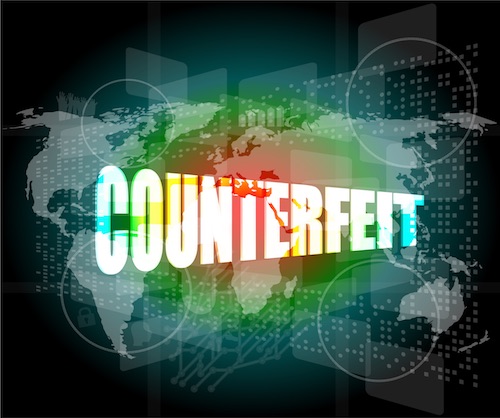 Counterfeit products are an enormous problem for businesses all over the world. Counterfeiters rip off name brand products, making cheap knock-offs, easily (and conservatively) costing many hundreds of billions of dollars each year. According to the Global Innovation Policy Center of the United States Chamber of Commerce, global physical counterfeiting amounts to $461,000,000,000 a year in imported fake goods.
Counterfeit products are an enormous problem for businesses all over the world. Counterfeiters rip off name brand products, making cheap knock-offs, easily (and conservatively) costing many hundreds of billions of dollars each year. According to the Global Innovation Policy Center of the United States Chamber of Commerce, global physical counterfeiting amounts to $461,000,000,000 a year in imported fake goods.
“Counterfeiting today represents a tremendous and ever-increasing global threat,” reads a 2016 report of the GIPC titled Measuring the Magnitude of Global Counterfeiting. “Counterfeit products— from goods and merchandise, tobacco products, and industrial parts to banknotes and medicines— circulate across the globe. These products cause real damage to consumers, industries, and economies.”
Counterfeiting is a far bigger story than loses to big companies and the associated loss of downstream economic activity, although those losses to jobs, loss of revenue and taxation, and inferior consumer products are all very real. Those that support counterfeiters by buying knock-off goods are also increasingly supporting organized crime, including drug cartels and terrorists, who are increasingly looking to the generous profits that can be earned and exceptionally low jail terms even if they do get caught.
“Interpol and Federal Bureau of Investigation seizure records suggest that millions of U.S. dollars in proceeds from counterfeit goods (e.g., brake pads and cigarettes) have been destined for terrorist organizations, such as Hezbollah and Al-Qaeda,” the 2016 GIPC report reads.
When we talk about the growing problems of counterfeits online, it is typical to looks at the major e-commerce players. And while large forums are an important and worrisome piece of the counterfeit problem, increasingly social media platforms like Facebook, Instagram and others are growing in importance for counterfeiters.
For brand owners the monitoring that is necessary is akin to playing a real life game of whack-a-mole, which is becoming all the more difficult as counterfeiters look more and more to sources, such as social media platforms, that were considered unsuspicious not very long ago. But today Facebook, Instagram and other social media channels are often matched with hidden web chats such as WhatsApp or Telegram in order to peddle counterfeit products.
“Fueled by the proliferation of internet use and social media platforms, the magnitude of global physical counterfeiting is estimated to have increased considerably since the beginning of this century,” according to the GIPC report.
And it appears that the rise of counterfeiting due to social media platforms has rather dramatically increased over the past several years.
For example, according to RedPoints, an online piracy and brand abuse monitoring company, during 2015 Facebook accounted for only 2.2% of counterfeits sales of football jerseys for the clubs they were monitoring. That number grew to 46.3% by 2017. With the infringements on Facebook typically being smaller in scale, RedPoints comes to the conclusion that counterfeiters have not merely left one channel for another, but instead are using multiple sales channels and diversifying their efforts.

![[IPWatchdog Logo]](https://ipwatchdog.com/wp-content/themes/IPWatchdog%20-%202023/assets/images/temp/logo-small@2x.png)

![[Advertisement]](https://ipwatchdog.com/wp-content/uploads/2024/04/Patent-Litigation-Masters-2024-sidebar-early-bird-ends-Apr-21-last-chance-700x500-1.jpg)

![[Advertisement]](https://ipwatchdog.com/wp-content/uploads/2021/12/WEBINAR-336-x-280-px.png)
![[Advertisement]](https://ipwatchdog.com/wp-content/uploads/2021/12/2021-Patent-Practice-on-Demand-recorded-Feb-2021-336-x-280.jpg)
![[Advertisement]](https://ipwatchdog.com/wp-content/uploads/2021/12/Ad-4-The-Invent-Patent-System™.png)







Join the Discussion
One comment so far.
Anand Kumar
June 3, 2018 01:38 amThe biggest menace in today’s world affecting a large population and all the organization to jointly work for defeating this.